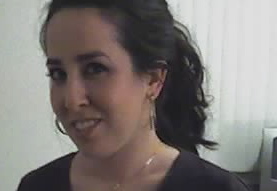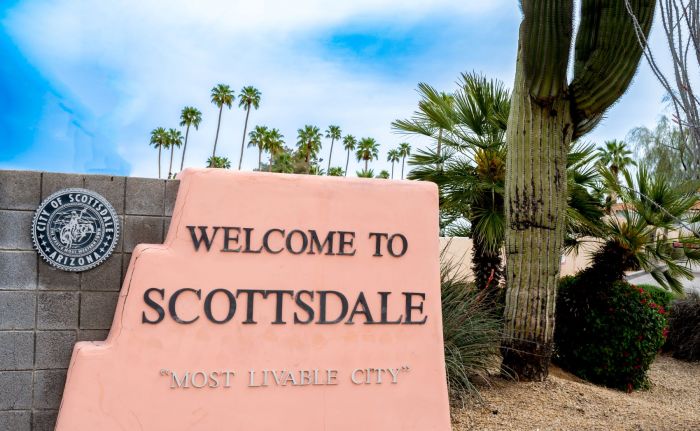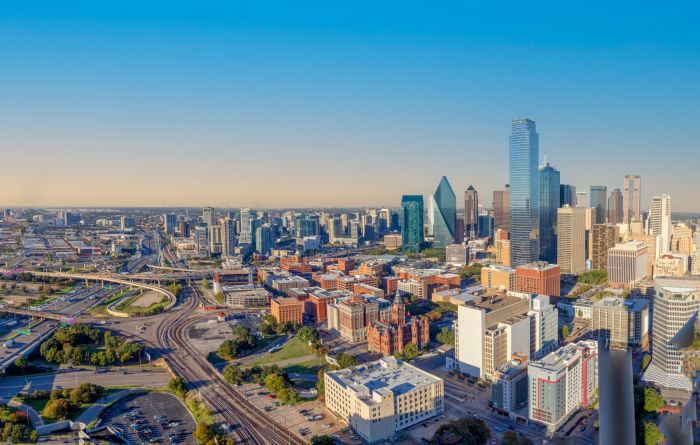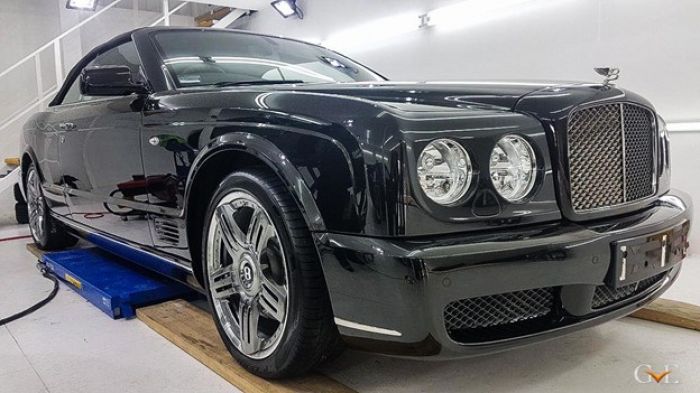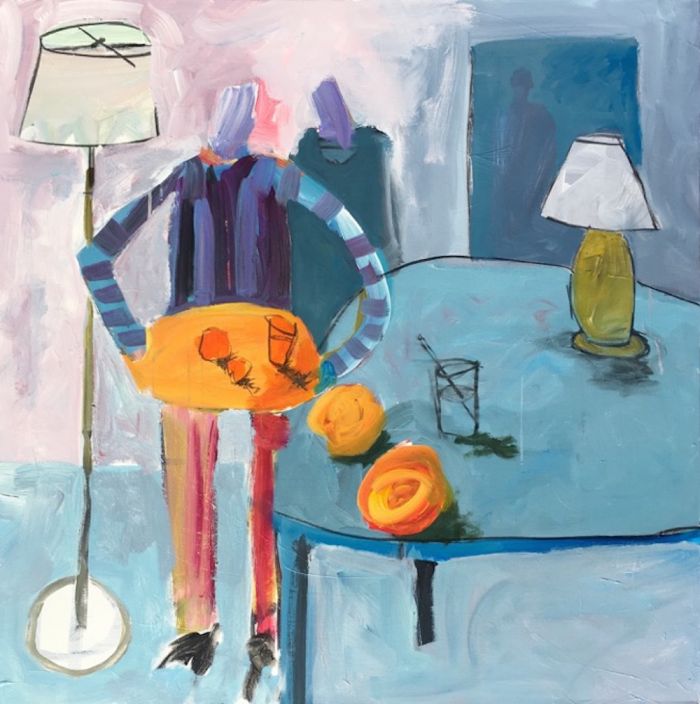
A psychotherapist by training and artist by passion, Robin Walker discovered his creative leanings late in life. Using his knowledge of psychology and psychotherapy, Walker brings emotions to life on canvas. He recognizes his own viewpoint and paints with deliberation on his canvas, pouring his thoughts and feelings onto the canvas to create works that are uniquely his own. In addition to creating his own art works, Walker has also created a community for others to do the same. His weekly Open Studio, is part collaboration and part soul session. What makes the Open Studio unique is that all but one of the students are psychotherapists who are looking to expand beyond the confines of academia. They’re looking for a life experience in which they can discover an expression of their true selves. Always working on multiple projects, Walker found time to tell JustLuxe about his work, his special insight into art from a different point of view.
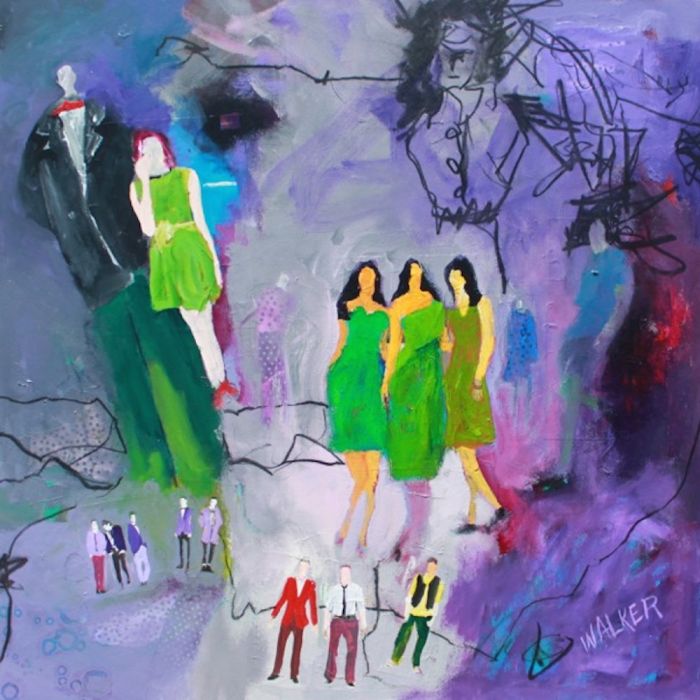
JustLuxe: When did you begin working as an artist?
Robin Walker: I’ve been an artist all my life. I didn’t realize this fact, though, until I was in my twenties. I was a psychology graduate student, on my way toward a career as a family therapist when I had a crisis—I realized that I should’ve gone to art school. I was a realistic young person, though, and knew that it was a mistake to start over. I also realized that it would be a problem if I was a therapist who encouraged people to trust their instincts and passions if I didn’t trust my own. So I made it my business to teach myself to paint. I knew nothing about artistic process because, as a youth, I had always denied my own urges to express myself.
My urge to create wouldn’t go away, though, and one day I found myself in an art store where I bought three tubes of watercolor paint, a brush and a single piece of watercolor paper. I drove these things around in the back of my car for about two months before I knew I had to just dive in. I did, and I’ve been painting almost every day since then.
I’ve been guided in my art by one essential idea: make it my own personal expression. I strive to make images that could only be made by me: brushstrokes that could only be made by me, colors that excite me, subjects that are part of my visual vocabulary and so forth. It’s easy to be derivative in art. It’s hard to be brave enough to reveal your true self in art. While painting, I always ask myself “Is it me?” While painting, I work very hard to lose my critical eye. As a therapist, I was trained to assess for dysfunctional behavior and for emotional problems and to know what to do about them, and I’m very good at that. But when I analyze myself, it throws me into states of anxiety. When I analyze my paintings, it paralyzes my creativity. I have to work hard to stay in the creative space and just respond to my painterly urges.
JL: How would you describe your art?
RW: I make art to bring joy and beauty to people, and to inspire conversation about important things. My art fits into the general category of figurative abstract expressionism, but mostly it’s about energizing a room. I want my work to embody innocence and immediacy, and to remind people of their own vitality. I reduce and rework the shapes and lines that make up my subject in order to grab the viewer in their guts. You don’t have to think too hard about my paintings, but you do have to engage your unconscious. It’s all about story. All my paintings have a story.
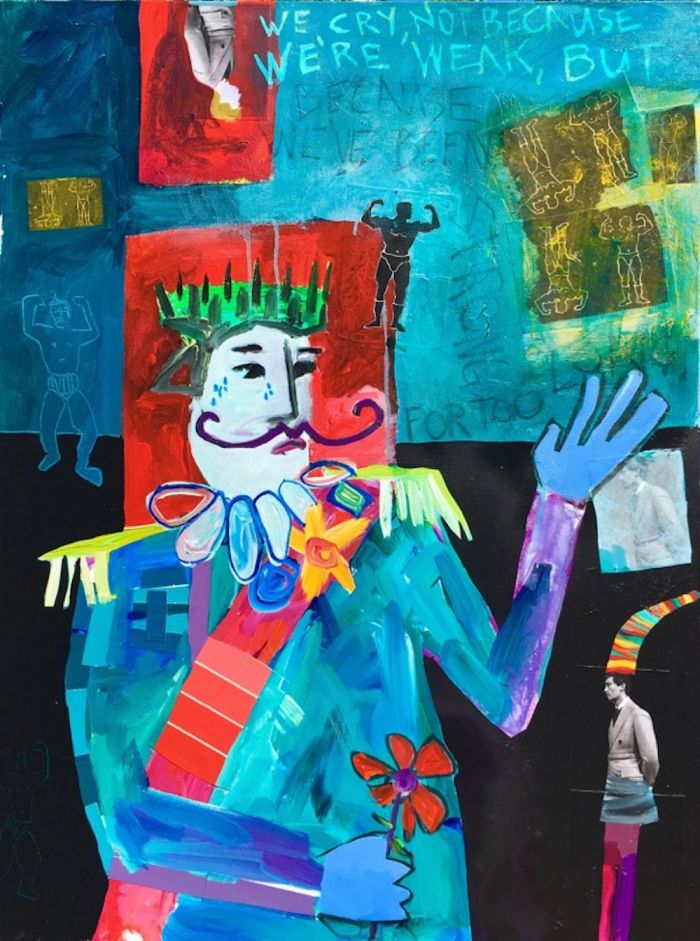
JL: Who were your primary influences?
RW: My primary influences weren’t artists, but psychologists. Early in my career, I encountered the work of Joseph Campbell, who described the universal stages in adult development. He wrote about the human need to follow a path that moves from dependence to authority. I really connected with that idea—that, as life goes on, we continuously grow and change and are always becoming our own true selves. I also connected with the ideas of Abraham Maslow, whose psychological work focused not on problems in living, but on positive qualities of people. That being said, I love David Hockney and Henri Matisse. They are both deceptively decorative. Their work draws you in with its beauty and energy, and then you start thinking about it. Their images just never go away.
JL: How would you describe your process and has it changed throughout the years?
RW: Before each painting session, I spend about 30 minutes straightening my studio. When I’m done, it’s still a mess, but I’m ready to paint. I need the ritual to enter my creative realm. I also need a messy space that I don’t have to clean up in order to grant myself creative freedom. I put on music and start by just putting color down without trying to “work.” That takes the critical voice away.
I keep my work loose and fresh by painting with my fingers, by using the wrong brushes—a small brush where a big one should be used to cover large areas, and a big one to work on details.) and by using paper towels to wipe paint off or put it on to create surprises.
I use a color wheel to keep me on track, but I’m not very good at staying true to it. The wrong color is often just right.
As a young painter, I conceived of my images and then painted them. They were stiff, but a good start. Now, I start with a concept and I spend a lot of time developing it without knowing what the final image will actually be. The creative process must have a big part in the work, and it’s my job to channel it.
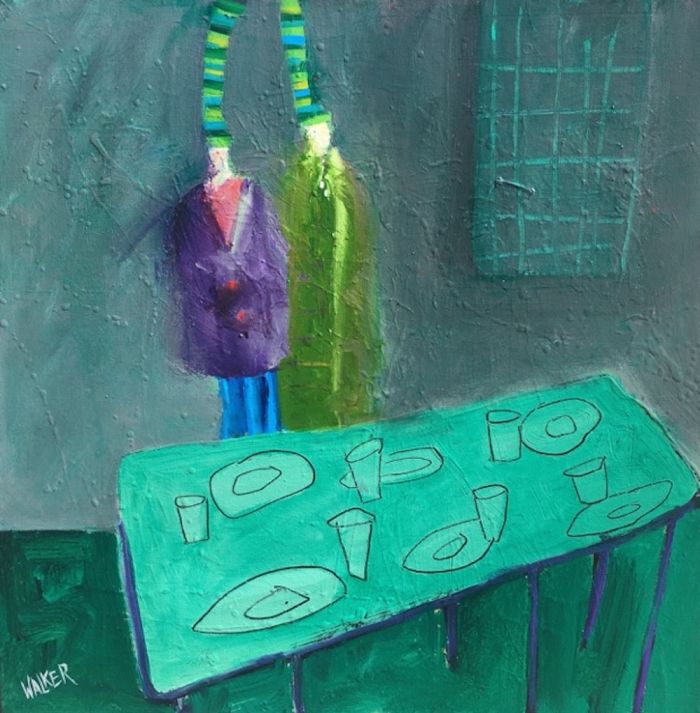
JL: You are also a psychotherapist. How do you feel art and therapy complement each other—if indeed they do?
RW: In psychotherapy, it is often a goal to help someone find their “true self” (as opposed to their False self—the one in which they work hard to meet the expectations of others while denying their own feelings and wishes). It’s wonderful have support and dialogue about that process, but it’s more wonderful to have the experience of that. The arts are a way to have the experience of one’s uniqueness. It’s incredibly meaningful to encounter yourself in a concrete, documented way, like a painting. I believe that everyone has artistic talent, it’s just that some of us are more practiced at it, or are more rabidly devoted to it.
Art is therapeutic, that’s all there is to it. Seeing your creative work and feeling the human endeavor of making it is existentially validating. It proves that I am someone who feels, and believes, and has vision, and is someone participating in life, and then whose work inspires others to respond and feel and think. It’s an incredible thing. In my practice, I sometimes just teach people to paint. No attempt at therapy made. Just create. I let the creative process be the teacher. That way it’s personal. As a therapist, I act as a guide into unknown territory. After all, I’ve been there before. I can inspire trust and confidence and the student’s life experience does the rest.
To believe that words can express everything we feel and experience is a mistake. There are other ways to have a conversation. Expression. Images. The way a mark is made. The connection made between two people who are each creating and sharing life.
JL: You also offer art workshops, how did those come about?
RW: My art workshops grew organically because people liked my loose and creative artistic approach and started asking if I taught art. I don’t actually teach painting lessons. I teach people to use materials and then help them move into their own creative space. My workshops are really about teaching people to let go of their inhibitions and self-imposed rules and just start expressing themselves. People are often intimidated by art because they are intimidated by the vulnerability of letting their true selves show.

JL: You have what you call your Open Studio each week. Tell me a bit about that.
RW: My Open Studio is when I invite people to come to my studio and work on their own projects. I’m there to offer technical ideas and to help them stay focused. On one of my walls I painted “YES, YOU SHOULD!” in big red letters. That’s because my students often ask things like “Hey, Robin, should I make this part bigger?” or “Should I make this part green?” or “Should I add another figure here?” Of course, if you have to ask the question, the answer is always YES, so I wrote it on the wall. My job is to help these painters unlock what they already know. I know how to get them to pour themselves into their creativity and be brave and bold.
All but one of my Open Studio students are therapists who craved creative process and found me. They come because it’s a place where they can expand their personal lives, which makes their professional skills better. These are therapists who don’t want to be limited by the confines of academia. They’re looking for a life experience in which they can discover an expression of their true selves. As therapists, we’re so focused on the needs of others and the conflicts of others, that it’s a real necessity to find an antidote. Sometimes therapists hide behind their professional roles so that they don’t have to be completely honest about themselves. It’s really easy to just answer a question with a question. “How does that make YOU feel?” We use empathy as a mask so we don’t have to reveal ourselves. In my Open Studio, people want to express themselves in a naïve and honest way. It’s invigorating. The secret is to respond and not analyze.
Jl: What are you currently working on?
RW: I’m working on three different series: Royalty, Identity/Attraction, and Dinner Party. My Dinner Party paintings are about taking care of each other. When we want to connect with people, we share a meal. We go to dinner or we have people over. These paintings depict people and table settings. Come in. Join us. It’s all about sharing and wanting to please each other. My Identity paintings have been focusing on men who “dress the part” or want to prove how strong they are. These paintings are about the lengths we’ll go in order to show that we’re worthy of love. My Royalty paintings use kings and queens as representations of our best selves. These are fun, lively images that just make you wonder “what’s the story here?”
JL: Where can people see your art?
RW: I’ll be showing at the Beverly Hills Art Show on October 21 and 22, Booth #322 at Beverly Gardens Park, and at the Mirrors of the Mind show on November 18 at L.A. ArtShare—801 E 4th Place, Los Angeles, CA 90013, 6 p.m. to 10 p.m.. This is a show exclusively of psychologists and therapists who are artists.










